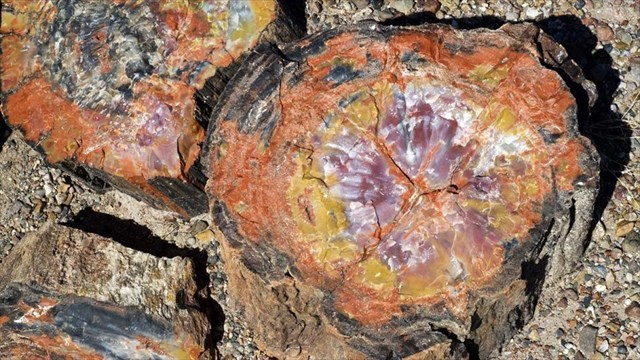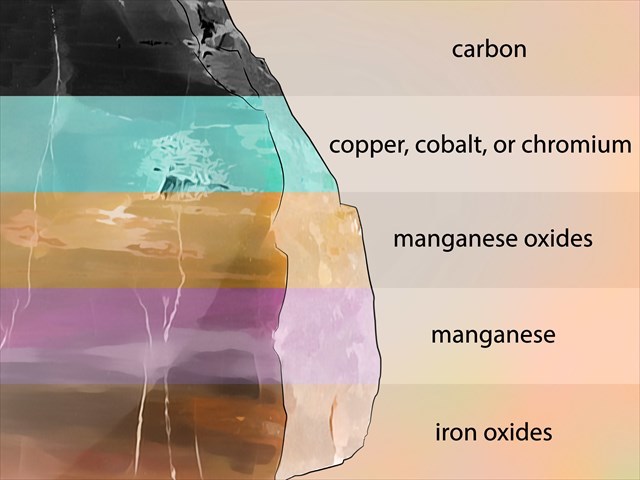Tree of St🌎ne EarthCache
Located just 29 miles from the Grand Canyon, this massive piece of petrified wood on display is estimated to be approximately 218 millions years old!

Colorful crystal patterns are displayed in a cross-section of petrified wood in the Petrified Forest National Park, located in northeast Arizona.
As this is an EarthCache, there is no container to find. Instead you will have an opportunity to learn about how wood can transform into a rock through a process called petrification. But before we begin, please note the following:
- This is an easy on/off stop on the way to the Grand Canyon.
- There is plenty of parking nearby.
To get credit for this EarthCache, be sure to complete the logging tasks at the bottom of this page.
What is petrified wood?
"Petrified wood" is the name given to a special type of fossilized remains of terrestrial vegetation. Petrifaction is the result of a tree having transitioned to stone by a mineralization process in which mineral deposits form internal casts of organisms. Carried by water, these minerals fill the spaces within organic tissue. From the Greek root petro (meaning "rock" or "stone"), petrified wood literally means "wood turned into stone".
How does wood become petrified?
When we look at petrified wood, we're looking at a long-dead tree that was turned to stone and yet still retained its basic structure. How is such a transformation possible? Well, it can only take place under the right set of circumstances.
When an organism dies, it usually decomposes. Such is the circle of life. The process that most people call "rotting" is a type of decay which sets in as microorganisms break down organic matter. Usually, a dead, fallen tree will be subjected to this process.
Once in a while, though, a newly-deceased tree (or some other kind of woody plant) gets rapidly buried by mud, silt or volcanic ash. This blanketing material then shields the dead tree from oxygen. Because oxygen is the main driving force behind the decaying process, the smothered plant will begin to decompose far more slowly than it normally would.
Meanwhile, mineral-laden water or mud seeps into the dead tree's pores and other openings. As our plant's internal structure gradually breaks down, its organic material (wood fibers) gets replaced by silica and other minerals. Over a period of a few million years, those minerals will crystalize into quartz. The end result is a rock that appropriates the shape and structure of our original tree!
Who cut the wood?
The answer is nobody. The settling of a heavy quartz log causes cracks and eventually breaks. Because it is the shortest distance for the crack to grow, the logs break perpendicular to their length, like a piece of brittle chalk. The repeating perpendicular breaks make the logs look like they were sawed or cut.
How does petrified wood take on different colors?

The wood, no longer wood at this point, takes on the hues of the minerals that fill its pores. The following list contains elements and how they relate to the different hues the petrified wood can take on:
- Black often indicates carbon presence.
- Blue or green shades are typically from copper, cobalt, or chromium.
- Yellow and blackish colors are often caused by manganese oxides.
- Orange and pink are due to manganese.
- Red, yellow, and brown shades are created by iron oxides.
To Get Credit For This EarthCache
Copy the questions above and send your answers via geocaching messages.
- DO NOT post the answers in your log.
- Group answers are fine, just let me know who all was there.
- Note: The photo task is a requirement for each account claiming a find. See acceptable EarthCache logging tasks effective June 10th, 2019. If you don't want to post the photo with your log, you may send it to me with your answers instead.
- Please send the answers in a timely manner or it may result in the deletion of your log (no offense intended).
Logging Tasks
1| The name of this EarthCache: Tree of St🌎ne
2| Describe the texture of the large tree trunk. Which direction do the cracks run on the trunk?
3| What colors do you see throughout the trunk and which element(s) do you think could have led to these colors?
4| Around the back of the tree in the middle, there is a section of color that is not on any other part of this tree. What color is this?
5| Describe the process of how this petrified tree was created.
6| In your log, provide a photo of yourself in front of the tree. Just make sure not to give away the answer to #4 in your photo. 😁
- If you prefer, the photo can be of a personal item here instead. Just make the photo unique to you and your visit. Feel free to have fun with this!
*IF YOU ENJOYED THIS EARTHCACHE,
CONSIDER GIVING A FAVORITE POINT!*
Sources:
Permission for this EarthCache placement was granted by the owner of this petrified tree.